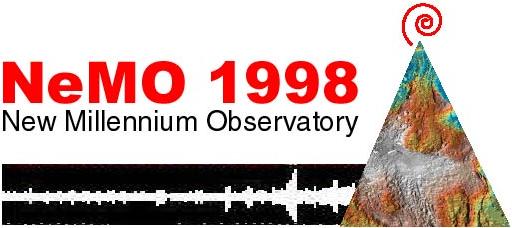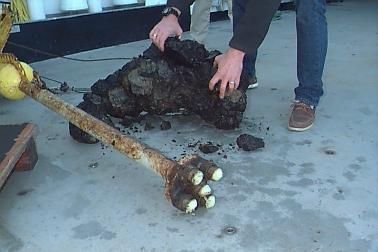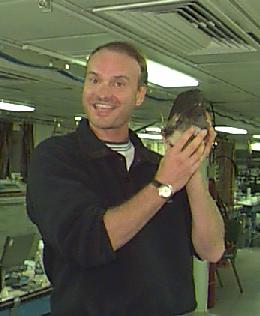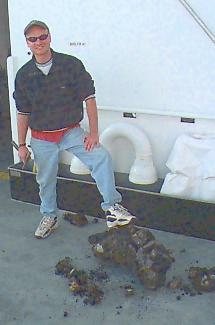WHAT'S NEW:
Eruption Confirmed!
New lava (rumbleometer stuck in flow) SE rift zone
(posted 9/1/98)
BACKGROUND:
Technology (ROV, ships, etc.)
Other 1998 Axial cruise reports
EXPEDITION:
Science Objectives
Calendar
Today's Science News
Participant Perspective
Teacher Logbook
EDUCATION:
Curriculum
Teacher Observations
Questions/Answers from sea
MULTIMEDIA:
(video clips, animations, sounds)

Logbook
September 4, 1998
September 4, 1998
Contents:
Science Report
Daily Science Report - Sep 4
ship's location = 45 56.0N/130 00.8W (directly over ASHES vent field)
The ROPOS dive that started yesterday (dive 465) to investigate the possible
eruption site
3 miles south of Axial's caldera (at 45 52.0/130 00) lasted 5 hours and was a
great success.
We suspected that lava had erupted at this site in January because a bathymetric
re-survey
(collected by scientists from the
Monterey Bay Aquarium Research Institute) in
May had shown up to
25 m of depth change on the south rift zone (link shows bathymetry difference on right maps). But you never
know
until you get down to the bottom and look. But when ROPOS got to the bottom,
 it quickly found a thick pile of
new "pillow-lava", a kind of underwater
lava flow that forms big round or tubular "pillows". This new flow had
extensive evidence
of having had warm water flowing through it as it cooled, including extensive
staining and
fluffy,
orange bacterial mats deposited on it (like we've seen up in the caldera
on other dives),
but it seems to have all stopped by now because we saw no warm water actively
venting.
Finding the lava flow and mapping its extent was very satisfying because it was
*exactly*
were we thought it was, and confirms the accuracy of our methods for remotely
detecting
the locations of seafloor eruptions.
The interval between dives again included CTDs and rockcores, and this time was
notable
because during one rockcore (which usually only samples a few grams of rock
during each
core)
it quickly found a thick pile of
new "pillow-lava", a kind of underwater
lava flow that forms big round or tubular "pillows". This new flow had
extensive evidence
of having had warm water flowing through it as it cooled, including extensive
staining and
fluffy,
orange bacterial mats deposited on it (like we've seen up in the caldera
on other dives),
but it seems to have all stopped by now because we saw no warm water actively
venting.
Finding the lava flow and mapping its extent was very satisfying because it was
*exactly*
were we thought it was, and confirms the accuracy of our methods for remotely
detecting
the locations of seafloor eruptions.
The interval between dives again included CTDs and rockcores, and this time was
notable
because during one rockcore (which usually only samples a few grams of rock
during each
core)
 a huge rock came up to the surface with the corer, wrapped up in the wire
that the
corer is lowered on! What a spectacular sample!
a huge rock came up to the surface with the corer, wrapped up in the wire
that the
corer is lowered on! What a spectacular sample!
ROPOS is now back on the bottom again (dive 466), this time at the ASHES vent field, which is near the SW caldera wall. This will be our first dive of many at ASHES - up until now all our dives have been in the SE part of the caldera on the upper south rift zone where lava was erupted in January (though we will be returning for more dives there as well). ASHES has many high-temperature "smoker" chimneys in addition to extensive areas of more diffuse venting and vent animal colonies. Water and biological sampling are scheduled.
Listing of all Science News postings
Life at Sea: Participant Perspective
John Chadwick
Graduate Student,
University of Florida

Once upon a time there was a geologist named John Chadwick, who spent a month on a big ship called the Ronald Brown. John was handsome, smart, honest, hard-working, resourceful, and very, very modest. One day our hero was taking samples of the sea floor using a heavy, torpedo-shaped device that collects tiny pieces of glassy rock that form when hot basaltic lava is quenched by the cold ocean water. The chemistry of this glass holds important clues to the origin and evolution of the lava that has erupted from Axial volcano and other related volcanoes on the rifted zone to the south of Axial. The torpedo device is sent down to the ocean floor, sometimes more than a mile down, on a long steel cable.
Well on one particular day, instead of tiny slivers of rock that weigh less
than a typical dust bunny, the cable had tangled itself around a rock the size
of a small house. OK, maybe I'm exaggerating a little, it would have to be a
VERY small house. The rock was in fact about three feet long and weighed in at
about 100 pounds! That's about one-quarter the weight and size of those really
big-boned people you see at the mall! Everyone on the ship was so excited about
the big rock that someone was actually overheard saying, "Look. A rock."

The geology of the Axial volcano area is actually very interesting, because
the volcano lies at the intersection of a
mid-ocean ridge and a chain of hotspot
volcanic islands. Mid-ocean ridges are places where new oceanic crust is
forming by volcanic processes, and are interconnected around the Earth like the
seams on a baseball. Hotspots are where hot plumes of magma from deep in the
Earth's mantle come to the surface, creating chains of volcanoes like the
Hawaiian Islands. These two volcanic processes are overlapping here at Axial
volcano, a situation that is very similar to Iceland. All of these processes
are driven by heat coming from within the Earth, heat created by the
decay of
radioactive elements and heat leftover from the Earth's formation 4.6 billion
years ago. All this volcanism is just the result of the Earth cooling itself
off and releasing heat, very similar to the hot air that politicians
release
during a speech. The interesting things that some of the other scientists on
the Brown are studying, like the hydrothermal vents and the strange creatures
that form around them on the ocean floor, all owe their existence to
these
underlying thermal and geologic forces that have created Axial volcano.

Our hero will continue to doggedly pursue his tiny pieces of rock, and the occasional boulder. He will study their chemistry upon his return to the University of Florida and try to unravel some of the mysteries of this interesting volcano. He is thoroughly enjoying the experiences aboard the ship, his first ever voyage to explore the geology under the sea. The sunsets and sunrises out in the Pacific are some of the most vivid and dramatic he has ever seen. The sun, clouds, and sea perform a mystical alchemy that cannot be matched on land. Dark blue waves and shimmering white clouds march by the ship like powerful legions in arms heading for a distant war. The ship is about the size of a typical hotel, so you'd think that claustrophobia might be a problem (The ship is in fact quite large (our hero still hasn't found the Men's bathroom.) Thank goodness for the Poop Deck!)). But outside, you can see 360 degrees of horizon, so one might also experience, well, whatever the opposite of claustrophobia is. Big-outside-phobia is the technical term, I believe.
Listing of all Perspectives postings
Teacher At Sea Logbook
Logbook of all Teacher At Sea postings
Question/Answer of the Day
Send Your Question to NeMO
(oar.pmel.vents.webmaster@noaa.gov)
Back to Calendar